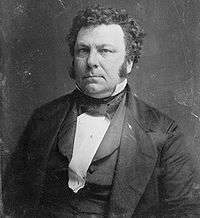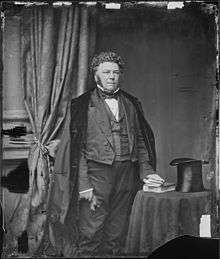James Pearce
| James Alfred Pearce | |
|---|---|
 | |
| United States Senator from Maryland | |
|
In office March 4, 1843 – December 20, 1862 | |
| Preceded by | John L. Kerr |
| Succeeded by | Thomas H. Hicks |
| Member of the U.S. House of Representatives from Maryland's 2nd district | |
|
In office March 4, 1835 – March 3, 1839 | |
| Preceded by | Richard B. Carmichael |
| Succeeded by | Philip Thomas |
|
In office March 4, 1841 – March 3, 1843 | |
| Preceded by | Philip Thomas |
| Succeeded by | Francis Brengle |
| Member of the Maryland House of Delegates | |
|
In office 1831-1835 | |
| Personal details | |
| Born |
December 14, 1805 Alexandria, Virginia, US |
| Died |
December 20, 1862 (aged 57) Chestertown, Maryland, US |
| Political party | Whig, Democrat |
| Alma mater | College of New Jersey |
| Profession | Politician, Lawyer |

James Alfred Pearce (December 14, 1805 – December 20, 1862) was an American politician. He was a member of the U.S. House of Representatives, representing the second district of Maryland from 1835 to 1839 and 1841 to 1843. He later served as a U.S. Senator from Maryland from 1843 until his death in 1862.
Biography
Early life
Pearce was in born Alexandria, Virginia, the son of Gideon Pearce and Julia Dick, and the grandson of Elisha C. Dick.[1] When he turned four years old, his mother died; his father moved to Louisiana to become a sugar planter, leaving his son in Alexandria to the care of grandparents.[2]
Pearce attended a private academy in Alexandria and entered the College of New Jersey (now Princeton University) in 1819. He graduated in 1822 at the age of seventeen with honors and started studying law in Baltimore under Judge John Glenn and attorney David Hoffman (1784–1854), an American legal ethics pioneer and author of Fifty Resolutions in Regard to Professional Deportment (1836). There was a requirement for aspiring jurists set by the Maryland legislature for at least three years of legal studies under the guidance of practicing lawyers (in 1831 it was lowered to two years).[3] Ahead of time, in 1824, Pearce passed exams and was admitted to the Maryland Bar, commencing practice in Cambridge, Maryland for a year. In 1825, Pearce moved with his father in Louisiana, and briefly engaged in sugar planting business, then he returned to Kent County, Maryland, in 1828, where he started the practice of law in Chestertown.
Family life
In 1829, Pearce married Martha J. Laird; they were raising 3 children in Chestertown, Maryland until 1845, when Martha died. In 1847, Pearce remarried, his new wife became Matilda Cox Ringgold; they had one child. His son, James Alfred Pearce, Jr., became a judge for the Maryland Court of Appeals.[4]
Political career
From 1831 until 1835, Pearce was a member of the Maryland House of Delegates. He was elected as a Whig to the Twenty-fourth and Twenty-fifth Congresses, serving from March 4, 1835 until March 3, 1839, but was an unsuccessful candidate for reelection in 1838 to the Twenty-sixth Congress, losing to Philip Thomas. He was again elected to Congress in 1840, and served one term from March 4, 1841, until March 3, 1843.
Pearce was again elected as a Whig to the United States Senate in 1843, and was re-elected in 1849, 1855, and 1861, the last time as a Democrat, and served from March 4, 1843, until his death in 1862. In the Senate, Pearce served for nineteen years as chairman of the Committee on the Library (Twenty-ninth through Thirty-seventh Congresses).[5] He also served in 1861 for two months as chairman of the Committee on Finance. In 1847-1862, he served as a member of the Executive Committee of the Regents of the Smithsonian Institution.[6] He was involved with the Coast Survey, which is among the U.S. governmental oldest scientific organizations, and the United States Botanic Garden.
In the U.S. Senate, Pearce became known as an erudite and pragmatist. In 1850, he developed the so-called Pearce Plan, a part of Compromise of 1850. The Pearce Plan provided a solution for the boundary dispute between Texas and the Federal government.[7] Pearce wrote a bill that granted Texas $10 million in compensation for agreeing with the state borders charted by the government. After being approved by Congress, the bill was signed by President Millard Fillmore.[8]
In 1850, President Fillmore offered Pearce, first, to become a judge of the United States District Court for the District of Maryland, and then, — Secretary of the Interior. Pearce chose to stay in the Senate.[9]
Political polarization caused by the issues of nativism, prohibition, and anti-slavery fragmented in 1852 the Whig Party, and in 1856, Pearce joined the Democratic Party, and supported James Buchanan's nomination for presidency. During the sectional crisis Pearce stood against the dissolution of the Union. However, he was hesitant to discuss the slavery issue being a slaveholder himself.[10] After the Civil War broke out, he did not resign. In March 1862, he appeared in the Senate for the last time.[11]
Pearce died in Chestertown on December 20, 1862, and is interred in New Chester Cemetery. His deathbed from the Hynson-Ringgold House was preserved and now exhibited in the historic Geddes-Piper House (c. 1770) in Chestertown, Maryland.[12]
References
- ↑ Ruth Lincoln Kaye (March–April 1994). "Cottage Farm". The Friends Sentinal. Alexandria Library Lloyd House Journal. VIII (2).
- ↑ Rodney P. Carlisle. Pearce, James Alfred. American National Biography Online, February 2000. Retrieved December 14, 2015.
- ↑ Michael Ariens. Lost and Found: David Hoffman and the History of American Legal Ethics. Arkansas Law Review, 2014, Vol. 67, p. 571-625.
- ↑ Horsey, Patricia J. O. Legendary Locals of Kent County. Arcadia Pub., 2015.
- ↑ Ostrowski, Carl. Books, Maps, and Politics: A Cultural History of the Library of Congress, 1783-1861. Amherst: University of Massachusetts Press, 2004.
- ↑ Appletons' annual cyclopaedia and register of important events of the year: 1862. New York: D. Appleton & Company. 1863. p. 682.
- ↑ Compromise of 1850, Lone Star Junction, a Texas history resource.
- ↑ Boundary Dispute
- ↑ Steiner, Bernard. James Alfred Pearce. Maryland Historical Magazine, Volume 17 (March 1922), p. 33-47.
- ↑ U.S. Congress. Addresses on the Death of Hon. James A. Pearce: Delivered in the Senate and House of Representatives, on Tuesday, January 13, 1863. Washington: Govt. Print. Off., 1863, p. 14.
- ↑ Hubbell, John T, James W. Geary, and Jon L. Wakelyn. Biographical Dictionary of the Union: Northern Leaders of the Civil War. Westport, Conn: Greenwood Press, 1995, p. 397.
- ↑ Daniels, D S. Ghosts of Chestertown and Kent County. Charleston, S.C.: History Press, 2015.
Further reading
- Steiner, Bernard. James Alfred Pearce. Maryland Historical Magazine, Volume 16 (December 1921), p. 319-39; Volume 17 (March 1922), p. 33-47; (June 1922), p. 177-90; (September 1922), p. 269-83; (December 1922), p. 348-63; Volume 18 (March 1923), p. 38-52; (June 1923), 134-50; (September 1923), 257-73; (December 1923), 341-57; Volume 19 (March 1924), p. 13-29; (June 1924), p. 162-79.
- Some Letters from Correspondence of James Alfred Pearce. Maryland Historical Magazine, Volume 16 (June 1921), p. 150-78.
- U.S. Congress. Addresses on the Death of Hon. James A. Pearce: Delivered in the Senate and House of Representatives, on Tuesday, January 13, 1863. Washington: Govt. Print. Off., 1863.
External links
- United States Congress. "James Pearce (id: P000161)". Biographical Directory of the United States Congress.
| United States House of Representatives | ||
|---|---|---|
| Preceded by Richard B. Carmichael |
Member of the U.S. House of Representatives from Maryland's 2nd congressional district 1835–1839 |
Succeeded by Philip Thomas |
| Preceded by Philip Thomas |
Member of the U.S. House of Representatives from Maryland's 2nd congressional district 1841–1843 |
Succeeded by Francis Brengle |
| United States Senate | ||
| Preceded by John L. Kerr |
U.S. Senator (Class 3) from Maryland March 4, 1843 – December 20, 1862 Served alongside: William D. Merrick, Reverdy Johnson, David Stewart, Thomas G. Pratt, Anthony Kennedy |
Succeeded by Thomas H. Hicks |
| Political offices | ||
| Preceded by Robert M.T. Hunter |
Chairman of the Senate Finance Committee 1861 |
Succeeded by William Pitt Fessenden |
